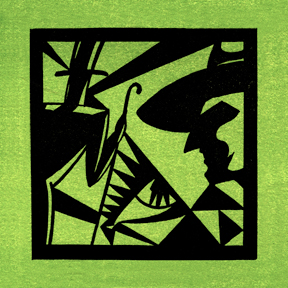Jimmy Starr began his career in Hollywood in the 1920s, writing the intertitles for silent shorts for producers such as Mack Sennett, the Christie Film Company, and Educational Films Corporation, among others. He also toiled as a gossip and film columnist for the Los Angeles Record in the 1920s and from 1930-1962 for the L.A. Herald-Express.
Starr was also a published author. In the 1940s, he penned a trio of mystery novels, the best known of which, The Corpse Came C.O.D., was made into a movie.
In 1926, Starr authored 365 Nights in Hollywood, a collection of short stories about Hollywood. It was published in a limited edition of 1000, each one signed and numbered by the author, by the David Graham Fischer Corporation, which seems to have been a very small (possibly even a vanity) press.
Here’s “Montmartre Memorabilia” from that 1926 collection.
MONTMARTRE MEMORABILIA
After climbing the stairs a pretty Titian-haired girl with blue eyes gives you a green check for your hat and coat.
Many of the chaps in Hollywood never wear a hat. It is economical, at least.
In the lobby the heavy carpet is checkered with black and white. After ascending two steps at the entrance to the cafe, one is greeted by a tall, black-haired man in a tuxedo.
Paul knows—knows whether one would accept a back table or demand a ring-side seat. That is Paul’s business. He is paid for knowing and reading the size of your pocketbook.
And Paul knows! He’s never missed yet.
The ceiling is very high. Beautiful cut glass chandeliers hang low, exhaling brilliant sparkles from their hidden incandescent bulbs. The walls are cream colored with a velvety finish and of the mid-Victorian period.
The south end faces upon the busy boulevard and is a solid row of high French windows, from which extend small balconies. At the other end the entrance and exit to the kitchen are cleverly hidden by a small backing. In front of this is placed the nine-piece orchestra, under the leadership of the famous composer, Vincent Rose.
The dance floor is a cedar square in the exact centre. There are four corner posts, to which are fastened a gauzy network called “The Shiek’s Tent.” This is drawn together, enclosing the floor after the dancing has begun.
Subdued clatter of dishes. Buzz of conversation. High-pitched laughter and coarse guffaws. Vincent is lightly fingering the piano. Shining teeth gleam between lips of dark red. Gowns of all hues. Shirt studs. Spotlights. Shining hair against the bronzed heads of men.
Fascinating.
The tables are terraced on wide stairs circling the dance floor. Around the walls is a continuous seat with tiny tables for two,—close together.
We are seated.
We exchange stares. It is the habit.
Everyone is trying to guess the identity of everyone else.
That is Hollywood.
A well-known film favorite enters and there is a loud buzz of talk. Praises, knocks, scandal. Everything is very Bohemian, yet there is a certain commercial undercurrent, which, to the true Bohemian, is obnoxious.
The music begins. There is a shoving back of chairs, hastily dropped cigarettes into china ashtrays. The girls effect graceful poses as they saunter to the dance floor. The men wear satisfied smiles. All are splendid dancers.
There is nothing so vain as a man—unless it is a woman!

